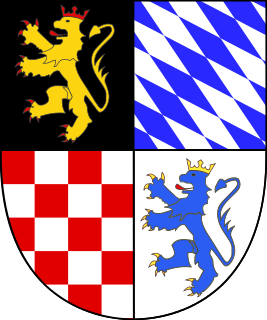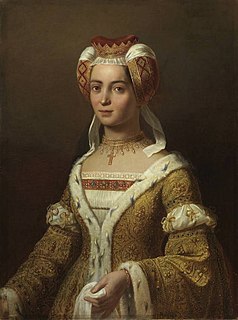
Sayn was a small German county of the Holy Roman Empire which, during the Middle Ages, existed within what is today Rheinland-Pfalz.
Henry III "the Great" was the count of Sayn (1202–1246), a county located near the Sieg River in northern Rhineland-Palatinate, Germany. Henry III shared the first year of his reign with his uncle, count Henry II, as he and his father Eberhard II had co-ruled the county. Gottfried II had been a regent from 1181 and continued until his death in 1220. John, count of Sponheim-Starkenburg, was regent from 1226 until Henry's death in 1246.
Palatine Zweibrücken, or the County Palatine of Zweibrücken, is a former state of the Holy Roman Empire. Its capital was Zweibrücken. Its reigning house, a branch of the Wittelsbach dynasty, was also the Royal House of Sweden from 1654 to 1720.

The Counts of Vianden, ancestors of the House of Orange-Nassau, were associated with the castle of Vianden in Luxembourg.
Engelbert II, a member of the House of Sponheim, was Margrave of Istria and Carniola from about 1103/07 until 1124. In 1123, he succeeded his elder brother Henry as Duke of Carinthia and Margrave of Verona which he held until his retirement in 1135.
Sponheim or Spanheim was a medieval German noble family, which originated in Rhenish Franconia. They were immediate Counts of Sponheim until 1437 and Dukes of Carinthia from 1122 until 1269. A cadet branch ruled in the Imperial County of Ortenburg-Neuortenburg until 1806.

Starkenburg is an Ortsgemeinde – a municipality belonging to a Verbandsgemeinde, a kind of collective municipality – in the Bernkastel-Wittlich district in Rhineland-Palatinate, Germany. It is the location of the like-named castle, now in ruins.

Sponheim is a municipality in the district of Bad Kreuznach in Rhineland-Palatinate in western Germany.

Dillendorf is an Ortsgemeinde – a municipality belonging to a Verbandsgemeinde, a kind of collective municipality – in the Rhein-Hunsrück-Kreis (district) in Rhineland-Palatinate, Germany. It belongs to the Verbandsgemeinde of Kirchberg, whose seat is in the like-named town.

The County of Sponheim was an independent territory in the Holy Roman Empire that lasted from the 11th century until the early 19th century. The name comes from the municipality of Sponheim, where the counts had their original residence.

Palatinate-Birkenfeld, later Palatinate-Zweibrücken-Birkenfeld, was the name of a collateral line of the Palatine Wittelsbachs. The Counts Palatine from this line initially ruled over only a relatively unimportant territory, namely the Palatine share of the Rear County of Sponheim; however, their importance steadily grew. All living members of the House of Wittelsbach descend from Palatinate-Birkenfeld, which thus became the parent branch of the Kings of Bavaria.

Dietrich VI, was Count of Cleves from 1260 through 1275. He was born in 1226 as the son of Dietrich V, Count of Cleves and Hedwig of Meissen.
Stephen I, Count of Sponheim is the patriarch of the Rhenish branch of the House of Sponheim, which ruled over the County of Sponheim. He was closely related to Siegfried I, Count of Sponheim, patriarch of the Carinthian Sponheimish branch, but the exact relationship between the two dynasts is disputed. Johannes Trithemius credits a Count Eberhard of Sponheim as founder of the Abbey of Sponheim and dates the founding to 1044, a position questioned by Johannes Mötsch. The Genealogia Sponhemica presents Count Eberhardus as son of Countess Hedwig and father of a single Count Stephenus I/II of Sponheim. Donald C. Jackman considers Stephen I a son of Siegfried I. Both Jackman and Josef Heinzelmann consider Stephen as being identical to Stephen, Vogt of Worms documented with his brother Markward in 1068. Heinzelmann however casts doubt on a male lineage relationship of Stephen and Siegfried and sees Stephen I of Sponheim as being Lord of Sponheim but not a Count, notices that Stephen I of Sponheim is documented in 1075 as "S(igna) Stepheni de Spanheim" with his seal in a document of Udo, Archbishop of Trier, and proposes Stephen to have married into the House of Sponheim. In another work Heinzelmann considers the Stephen mentioned in 1075 to be Stephen II, or maybe a single Stephen, mentions a Mainzer ministerialis Stephen, the son of Embricho (Emich) and nephew of Archbishop Ruthard, who lived later, as a possible relation, and puts forward that the documented Stephen and Markward belong to the House of the Counts of Metz/Lunéville, which later provided the Vogts of Worms:
"Identisch kann er sein mit einem Wormser Vogt Stephen (1068) [239 UB Stadt Worms I, Nr. 55], der mit seinem Bruder Markwart zu den Grafen von Lunéville/Metz zu gehören scheint, die mit den de Meti später die Wormser Vögte stellen."

Johann III, Count of Sponheim-Starkenburg, the Older, reigned over the County of Sponheim for 67 years. He also received many epithets such as "the Noble" and, because of his declining vision, "the Blind".

Anne of Veldenz was a Countess suo jure of Veldenz. She was a member of the Hohengeroldseck family, the second family to rule Veldenz.
Simon II of Sponheim was a German nobleman. He was a member of the House of Sponheim and a ruling Count of the County of Sponheim.
Henry I, Count of Sponheim was a German nobleman of the house of Sponheim. He was the count of Sponheim from 1266 until his death.
John V, Count of Sponheim-Starkenburg was a German nobleman. He ruled the paternal line of the county of Sponheim from 1414 and the re-unified county of Sponheim from 1417 until his death. He was the last of the Sponheim-Starkenburg line - after his death the county split between Jacob, Margrave of Baden-Baden and Frederick III, Count of Veldenz.
Frederick III, Count of Veldenz was the last from the Hohengeroldseck family to rule the county - that male line died out with him, and the county passed to his son-in-law Stephen, Count Palatine of Simmern-Zweibrücken, widower of Frederick's daughter, Anna of Veldenz.
This page is based on this
Wikipedia article Text is available under the
CC BY-SA 4.0 license; additional terms may apply.
Images, videos and audio are available under their respective licenses.









